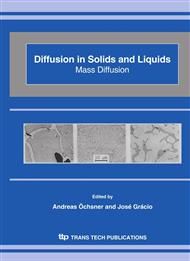p.390
p.397
p.403
p.409
p.415
p.421
p.427
p.433
p.442
The Influence of Post-Quenching Deep Cryogenic Treatment on Tempering Processes and Properties of D2 Tool Steel. Studies of Structure, XRD, Dilatometry, Hardness and Fracture Toughness
Abstract:
A significant increase in durability of cryogenically treated tools after quenching was reported by a number of publications [1, 2]. As research studies show [4, 5, 6, 7], the main reason for this is the kind of carbides precipitated during tempering at temperature range of 150 –200 0C, which is different than in the case of conventional treatment. These carbides are finer and more evenly distributed in the matrix of steel. The number of carbides is higher than in conventionally treated steels because of higher fraction of martensite in cryogenically treated steels produced by retained austenite transformation at cooling to deep cryogenic temperatures. The number of carbides precipitated from martensite at low temperatures of tempering is proportional to shrinkage produced at the same temperatures of tempering. Calculations on the basis of dilatometric experiments show that the shrinkage difference between the same D2 steel cryogenically and conventionally treated is higher than that which results from the increased fraction of martensite in cryogenically treated steel. The XRD studies of cryogenically treated steel show a presence of two kinds of martensites differing in tetragonality. Low temperature tempering of cryogenically treated steel produced two types of carbides – ε carbide and η carbide. The conventionally treated steel consists of one kind of tetragonal martensite and one kind of carbide - the ε carbide. The hardness of cryogenically treated samples was somewhat higher than in conventionally treated ones, while fracture toughness of conventionally treated samples was somewhat higher than in cryogenically treated ones. The results obtained were discussed in reference to literature data.
Info:
Periodical:
Pages:
415-420
Citation:
Online since:
October 2006
Authors:
Price:
Сopyright:
© 2006 Trans Tech Publications Ltd. All Rights Reserved
Share:
Citation:


